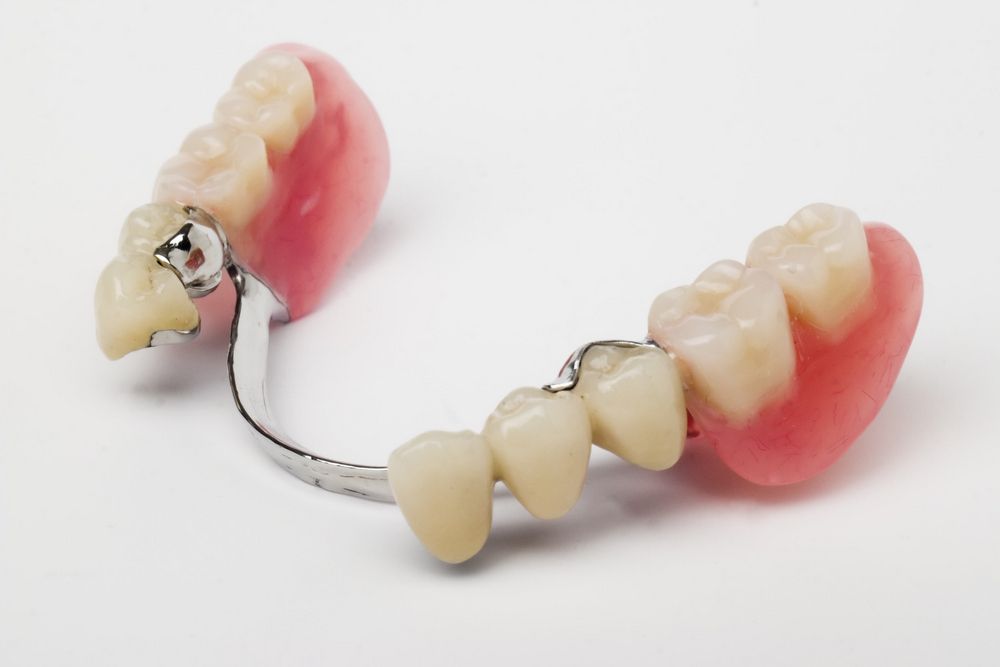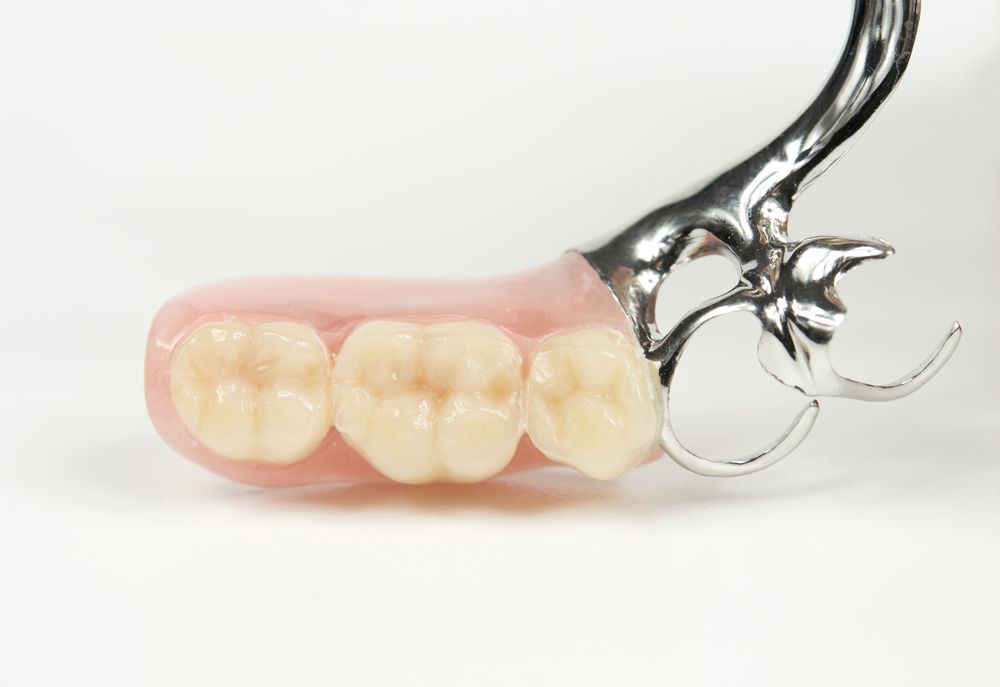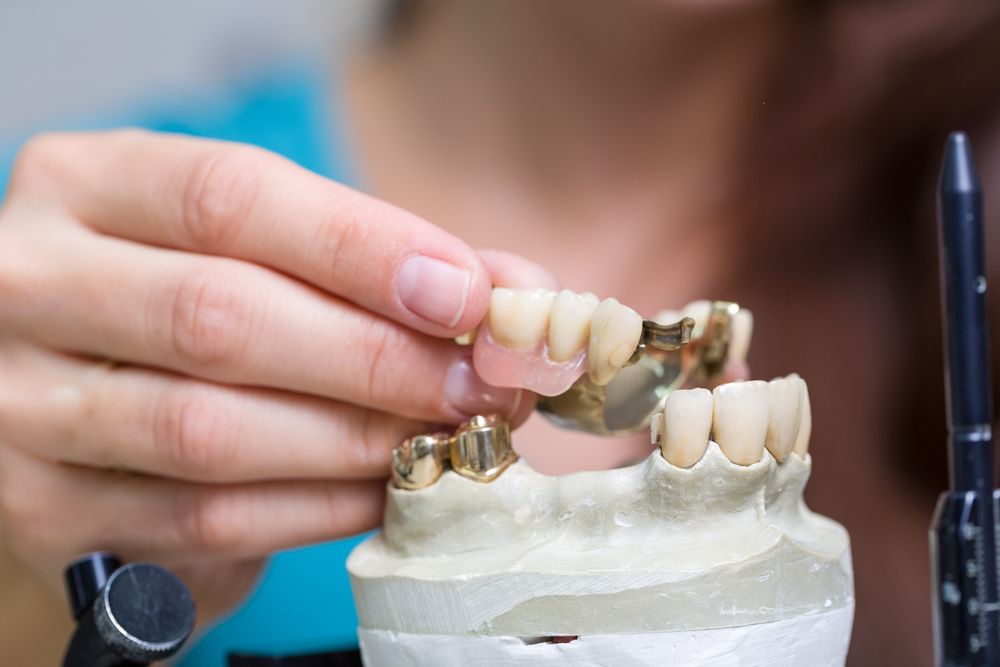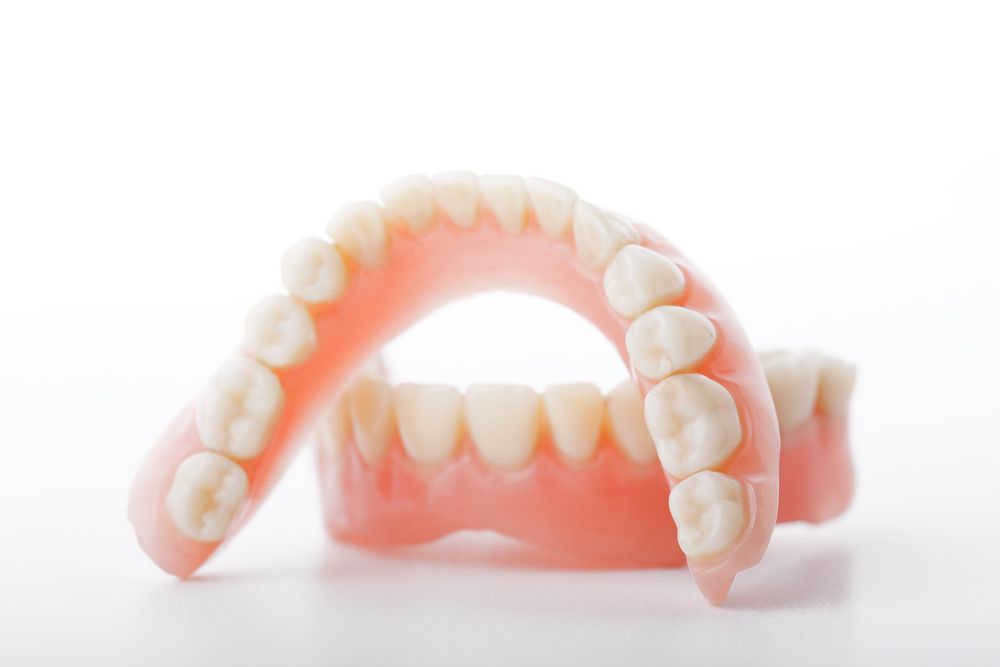
Partial dentures
Partial dentures are removable dental prostheses. They are an option when not enough teeth are left to allow for a stable bridge solution. This tends to be the case when seven or more of the teeth in a tooth arch are missing. As a temporary solution, partial dentures are used during the healing period after the placement of implants. Partial dentures restore oral function and aesthetics after loss of a considerable number of teeth. Partial dentures include or may include these elements:
- a framework made of medical steel (in the upper jaw mostly in form of the lingual plate that fits closely to the palate, in the lower jar as a metal bar or bracket
- varying retainers: connectors, clasps or attachments depending on the type of the denture
- a soft lining to protect the gums from getting sore
- a gum-colored plastic base
- artificial teeth made from ceramics or plastic with customized form and color
When a bridge would still be an option, partial dentures are the more affordable alternative. But in many other regards, partial dentures are inferior to bridges: their wearing comfort, fit and aesthetics are not a match for the better performance of a bridge. Dental hygiene can be a challenge, and the risk of gingivitis as well as the caries risk for the remaining teeth are higher with dentures than with bridges. A partial denture must be connected to the teeth on at least one side. Alternatively, it can be connected to implants.
You can get further Informations about the costs of removable dentures in our download section(german only) or directly in our Practice in 1010 Vienna.
Partial denture with clasps
There are several types of partial dentures. Their distinguishing features are different solutions for fastening the denture to the teeth. A classic partial denture is retained by visible metal clasps that hug the adjacent natural teeth: a quick and affordable solution. Healthy natural teeth may be outfitted with a crown for protection.
The disadvantage of a partial denture retained by clasps is the wear it imposes on the abutment teeth: The clasps may rub off their enamel, and the combined masticating pressure of an entire area of the tooth arch is transferred to the abutment teeth in a quite unphysiological, horizontal way, effectively acting as a lever that may compromise the stability of the teeth. Particularly in the frontal area, visible metal clasps are an aesthetic disadvantage of this type of partial denture.

Combined dentures
Compared to clasp dentures, a number of modern partial denture solutions summarized under the name combined dentures offer better wearing comfort and superior aesthetics. Combined dentures are partial dentures that are combined with a bridge, crown or implant crown with built-in retaining elements. There are different precision attachment systems, all of them less conspicuous and more stable than the conventional metal clasp.
- There is the T-shaped precision attachment that works according to the tongue-and-groove principle: a box-shaped metal receptacle (matrix) in the side or back of the crown of the abutment tooth is designed to precisely fit a T-shaped bar (patrix) that is attached to the removable denture
- Telescopic dentures are mounted on two telescopic gold crowns, the primary crowns that are cemented to the abutment teeth. The secondary crowns are integrated in the prosthesis. They fit over the primary crowns like one part of a telescopic cylinder into the other, holding the denture through frictional force. The resulting fit is comfortable and surprisingly tight, and the vertical pressure transfer to the abutment teeth is very similar to the natural circumstances. A very similar alternative are conical crown-retained dentures that differ from telescopic dentures only in the form of the crowns, which are, as the name implies, cone-shaped.
- Bar-and-sleeve attachment dentures are a good solution for the lower jaw, particularly for situations where the two healthy canines are preserved. The canines are fitted with crowns that are connected with a bar. The prosthesis contains a sleeve that is clamped over the bar and lends considerable stability to the removable denture.
- There are many other possibilities to retain dentures with the help of crowns or implants, among them bolts, stud anchors or magnetic retainers

The inconspicuous attachment solutions of combined dentures have different strenghts and weaknesses. Which one is best for each particular case depends on the number and location of the remaining teeth, on periodontal health, on the available space for external retaining elements and on foreseeable future tooth loss.
Cost-optimized combinations of implants, crowned teeth, bridges and removable partial dentures can achieve results that are a) affordable and b) functionally and aesthetically pleasing. Insurance providers subsidize the cost for crowning a number of abutment teeth that are supposed to serve as anchors for partial dentures. Attachment solutions that go beyond clasps are strictly private services though.
Time frame for fitting patients with a partial denture
Removable partial dentures can be fitted, manufactured and placed in a comparatively short time. The fastest solution is the clasp denture: Ready and done in one week.
Precision attachment dentures need a bit more time: Expect four appointments in the course of four weeks. We must take more than one impression and have the dental lab perform extensive work.
Indications for, and arguments in favour of removable partial dentures:
- a solution, if there are enough natural teeth left to retain a partial denture, but too few to support a bridge
- fast completion
- an affordable outcome is the main focu
Implants and implant-supported bridges create a more stable dental situation than removable partial dentures. They are also favourable for the jaw bone. If at all affordable, these solutions are thus clearly preferable to removable dentures in the long run. If the placement of implants is not possible due to financial or health concerns, of because of insufficient volume of the jaw bone, combined precision attachment dentures are the second best option.
Complete dentures
Complete dentures – false teeth – used to be the only option for patients with completely toothless gums. Implants and implant-supported bridges have opened up a whole new array of possibilities that we recommend patients consider thoroughly before deciding in favour of a full denture. The base of a modern full denture is made from the synthetic material PMMA (acrylic resin). Due to it’s excellent biocompatibility and other interesting properties PMMA is used for many medical application from artificial lenses to hearing aids. With the help of an impression, PMMA is individually molded to fit the alveolar ridge, for an upper jaw prosthesis also the palate of a patient. The artificial teeth – usually made from PMMA, too – are inserted into the base of the denture.
How are complete dentures retained in the mouth?
The most important retaining force for a complete denture is suction between the base of the denture and the gums. To create stable suction, the rim of the denture must be precisely made and well aligned with the form of the jaws. Saliva seals the space between denture base and gums, preventing air to enter and break the suction. Thus, saliva is an important element for denture retention. A dry mouth often causes retention problems.

With habituation, tongue and oral muscles take on a stabilizing role for the denture, too. Thorough manufacture of the denture base includes the creation of an elaborate functional impression that takes into account movements of the mouth during the play of the masticatory and mimic muscles, and the precise shaping of the denture’s borders. Today, we can produce dentures that have satisfactory retention even for unfavourably shaped jaws or for alveolar ridges that are strongly reduced by bone loss. If problems with retention occur, a possible solution is the placement of a small number of implants that – after some minor alterations to the denture base – may help retain the denture. Implants can also reduce the pressure of the denture on the alveolar ridge.
Time frame for fitting patients with a complete denture
A complete denture is generally fitted in the course of four weekly appointments. After the creation of an initial impression, the second appointment is reserved for taking a functional impression and for a thorough bite registration. Here, we determine the correct placement and size of the replacement teeth in the upper and lower jaw (not always a straightforward task if there are no teeth left to go by). During the third appointment, a temporary wax model of the denture is tried on and corrections are made, if necessary. Now the lab can produce the final version of the denture, which is presened to you at the fourth appointment. You will return for one or several aftercare appointments, where we determine whether there are any sores or pressure points. If so, we will correct the form of the denture base to ensure a more comfortable fit.
Indications for, and arguments in favour of complete dentures:
- a solution for the toothless upper and/or lower jaw
- fast completion
- very affordable option
- suitable if implants are not an option
